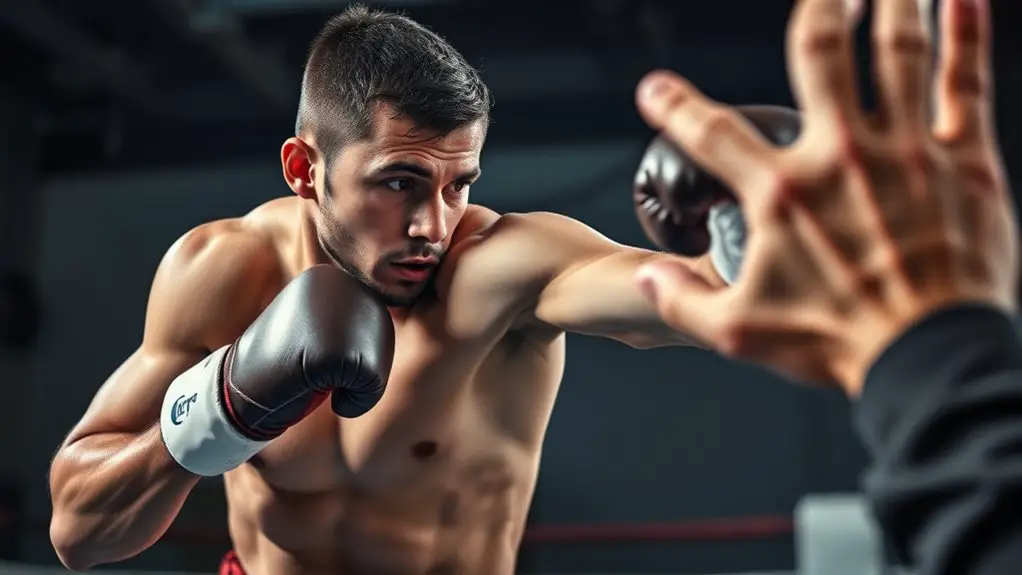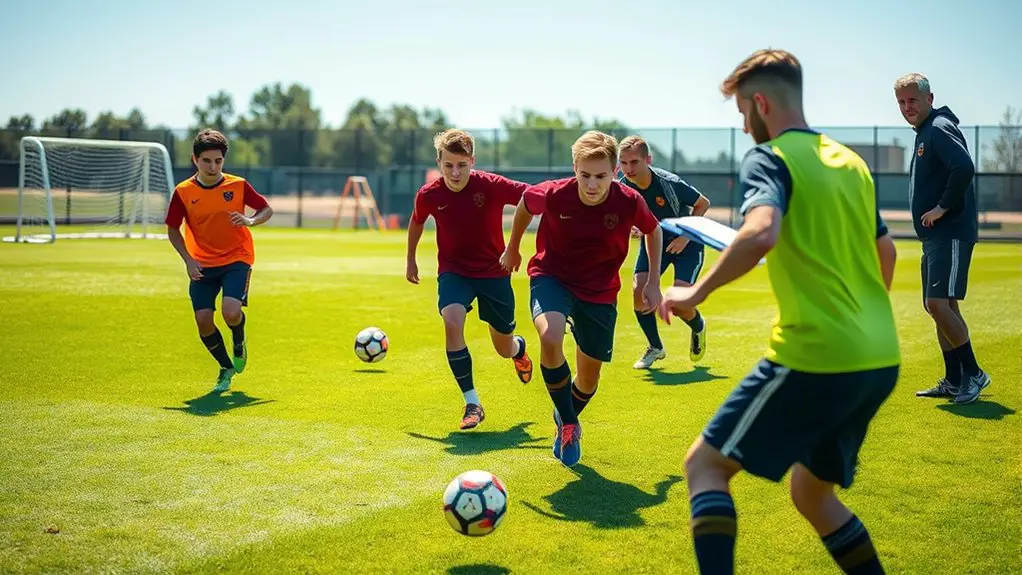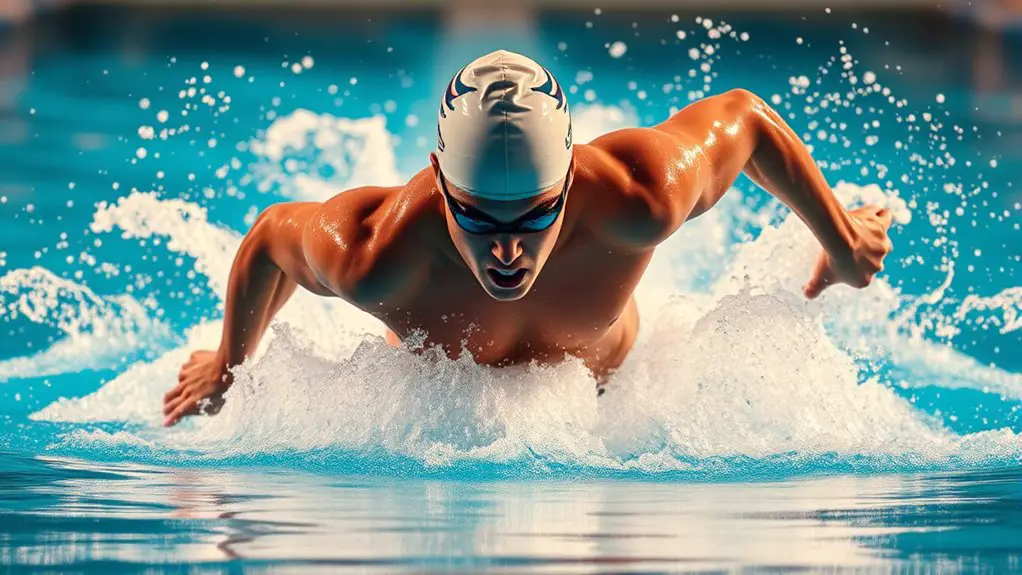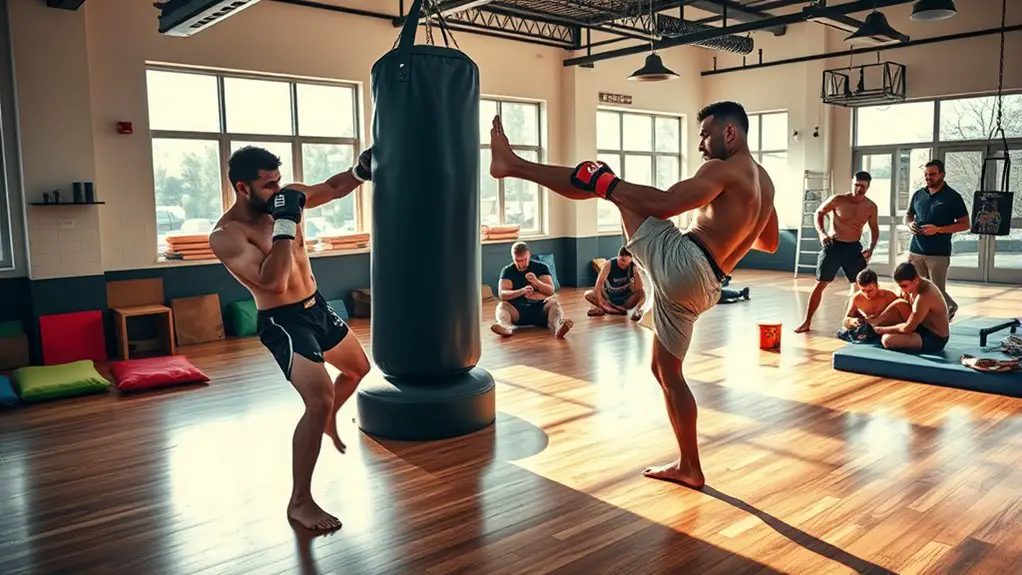To develop your defensive reflexes and head movement in boxing, start by mastering your stance and positioning. Keep your feet shoulder-width apart and practice fluid footwork for better agility. Incorporate shadowboxing and partner drills to sharpen your timing and instincts. Use visualization techniques to boost your confidence and enhance your reaction time. By analyzing successful fighters, you can learn effective strategies. Stay consistent in your training, and you'll discover even more ways to improve your defensive skills.
Understanding the Importance of Defensive Reflexes
When you're in the ring, understanding the importance of defensive reflexes can make all the difference in your performance. These reflexes are your first line of defense, helping you evade punches and maintain control. By honing your defensive strategies, you're not just reacting; you're anticipating your opponent's moves. Reflex training is essential to develop that instinctive response, allowing you to slip, duck, or block with ease. Incorporating core strengthening exercises into your training can also enhance your stability and power, further improving your defensive maneuvers. Imagine knowing exactly when to move, freeing you from the fear of getting hit. The more you practice, the sharper your reflexes become. Incorporating drills that focus on speed and accuracy will sharpen your reactions, giving you the freedom to express your style without hesitation. Remember, every moment in the ring counts, and mastering your defensive reflexes can turn the tide in your favor. Embrace the training and watch your confidence soar as you navigate every challenge with agility.
Basic Stance and Positioning for Effective Defense
A solid stance is the foundation of effective defense in boxing. Your stance alignment should keep you balanced and poised, allowing for quick movements in any direction. Stand with your feet shoulder-width apart, and angle your body slightly sideways to present a smaller target. This positioning enhances your defensive posture, making it harder for opponents to land clean shots.
Keep your knees slightly bent and your weight evenly distributed between your feet. Your hands should be up, guarding your face, while your elbows remain close to your body for added protection. Remember, a relaxed stance enables fluid movement; tense muscles can restrict your agility.
Staying grounded in this stance allows you to absorb hits while maintaining the freedom to react effectively. As you practice, you'll find that a strong stance not only protects you but also empowers your ability to respond and counterattack. Embrace this foundation in your training! Additionally, incorporating proper warm-up techniques into your routine can further enhance your defensive reflexes and overall performance.
The Role of Head Movement in Avoiding Strikes
Building on your solid stance, head movement plays an essential role in avoiding strikes. By mastering head movement techniques, you can evade punches and kicks, keeping you agile and unpredictable in the ring. Instead of relying solely on your arms for defense, incorporate head movement to create angles that make it harder for your opponent to land hits.
When you slip, duck, or weave, you're not just avoiding strikes; you're setting yourself up for counterattacks, striking back when your opponent least expects it. Wearing defensive headgear while practicing these techniques can boost your confidence, allowing you to experiment without fear of getting hurt. Engaging your core engagement allows you to maintain stability and generate power for effective counterstrikes.
Embrace head movement as a crucial aspect of your defensive strategy. It grants you the freedom to control the fight and enhances your overall skill set. Remember, the more you practice, the better you'll become at avoiding those dangerous strikes.
Key Drills for Improving Reflexes
To sharpen your reflexes, incorporating shadowboxing techniques and reaction ball exercises is essential. These drills not only enhance your defensive skills but also improve your overall agility. Additionally, practicing mental alertness through visualization techniques can help you anticipate movements more effectively, further elevating your training. Let's explore how each of these methods can make a difference in your training.
Shadowboxing Techniques
Shadowboxing offers an excellent opportunity to sharpen your reflexes while honing your technique. When you practice, focus on fluid movements and your head movement, integrating different shadowboxing variations. Try incorporating feints and slips to simulate real fight scenarios, enhancing your defensive awareness. The shadowboxing benefits extend beyond just physical skills; they also boost your mental agility and spatial awareness. Use mirrors or video to analyze your form, ensuring you're not just going through the motions. Experiment with different tempos, switching between fast-paced bursts and slower, deliberate movements. This keeps your body guessing and improves your reaction time. Remember, the more you engage with these techniques, the sharper your reflexes will become, giving you that freedom to move confidently in the ring.
Reaction Ball Exercises
After honing your technique with shadowboxing, it's time to add another layer to your training: reaction ball exercises. These drills can greatly enhance your reflexes and agility, giving you the freedom to move fluidly in the ring. By using a reaction ball, you'll improve your hand-eye coordination and reaction time, two essential skills for any fighter.
To get started, try these reaction ball techniques: throw the ball against a wall and catch it as it bounces back, or work with a partner to keep it unpredictable. The reaction ball benefits are immense; it sharpens your instincts and helps you develop quicker responses to incoming punches. Incorporate these exercises into your routine, and watch your defensive reflexes soar!
Shadowboxing Techniques to Enhance Head Movement
A key aspect of effective boxing is mastering head movement, and incorporating specific shadowboxing techniques can greatly enhance this skill. By focusing on head movement drills during your shadowboxing sessions, you'll develop a natural rhythm that keeps you light on your feet and elusive.
- Imagine slipping punches as you weave your head side to side, feeling the air brush past your skin.
- Visualize ducking under imaginary jabs, your body flowing like water, avoiding obstacles with ease.
- Picture rotating your shoulders while pivoting, creating angles that confuse an unseen opponent.
- Envision bobbing and weaving, your head bobbing like a cork on waves, effortlessly evading strikes.
Incorporating agility training techniques into your routine can further elevate your defensive reflexes. With practice, you'll find your shadowboxing rhythm becomes a dance, allowing you to evade and counter with freedom, making every movement feel instinctual and fluid. Embrace these techniques, and watch your defensive skills soar.
Partner Drills for Real-Time Reaction Training
Building on the head movement techniques practiced in shadowboxing, partner drills offer a dynamic way to sharpen your defensive reflexes in real-time scenarios. By working with a partner, you can enhance your reaction timing while fostering effective partner communication. Start with simple combinations, where your partner throws light punches, and you focus on slipping, ducking, or weaving. Make sure you both agree on the intensity to maintain a safe, yet challenging environment.
As you grow more comfortable, gradually increase the speed and complexity of the drills. Encourage your partner to mix up their attacks unpredictably, pushing you to react quickly and decisively. This back-and-forth interaction not only sharpens your reflexes but also builds trust and understanding between you and your partner. Additionally, practicing mindfulness techniques can help you stay present and react more effectively during these drills. Ultimately, these drills will help you develop the instinctive head movement that's essential for evading strikes in real fights, giving you a sense of freedom in your defensive approach.
Incorporating Footwork for Better Defensive Maneuverability
While developing your defensive skills, incorporating footwork can greatly enhance your maneuverability during a fight. Mastering footwork drills helps you evade attacks while maintaining balance and control. Focus on lateral movement; it's key to dodging punches and creating angles.
- Picture yourself gliding effortlessly across the ring.
- Imagine the thrill of sidestepping a powerful strike.
- Visualize how quick pivots can set you up for counterattacks.
- Feel the freedom that comes from being light on your feet. Additionally, practicing agility ladder drills can improve your foot speed and coordination, further enhancing your defensive capabilities.
The Impact of Visualization and Mental Training
Although physical skills are essential in boxing, mental training and visualization can greatly enhance your performance in the ring. By incorporating visualization techniques, you can mentally rehearse defensive moves and head movement, creating muscle memory that translates into real-life scenarios. Picture yourself dodging punches and slipping past your opponent's attacks; this kind of mental imagery not only boosts your confidence but also sharpens your reflexes.
When you visualize, you're not just dreaming; you're programming your mind to react swiftly and effectively under pressure. Take time each day to close your eyes and imagine yourself in various fight situations. Feel the rhythm of the match, anticipate your opponent's moves, and practice your defensive strategies in your mind. With consistent mental training, you'll find that your body responds more instinctively, allowing you to flow freely and confidently in the ring. Remember, the mind is a powerful ally in your boxing journey, as it activates neural pathways similar to actual performance, enhancing your overall athletic capabilities.
Analyzing Fights: Learning From the Masters
Analyzing fights provides invaluable insights that can elevate your boxing skills and understanding of the sport. By studying the masters, you'll grasp fight analysis concepts that enhance your performance metrics and fight IQ. Here's how to immerse yourself:
- Technique breakdowns reveal how champions execute defensive strategies against various opponent tendencies.
- Fighter styles show the adaptability of different approaches, from aggressive to counter-punching.
- Historical techniques provide context, showcasing how past legends influenced modern training philosophies.
- Matchup evaluations allow you to anticipate opponents' moves, improving your own defensive reflexes. Additionally, embracing mental toughness can help you overcome challenges and improve your performance during fights.
Consistency and Progress Tracking in Your Training
To truly excel in boxing, maintaining consistency in your training and tracking your progress is essential. Start by setting clear goals that resonate with your desire for freedom in the ring. Incorporate progress measurement through regular skill assessments, which will give you insight into where you stand. Use reflective journaling to document your training experiences, helping you identify patterns and areas needing improvement.
Establishing training consistency is key; create a routine that fosters habit formation and stick to it. Build feedback loops by seeking input from coaches and peers, ensuring you're on the right path. Don't hesitate to make routine adjustments as necessary to keep your training dynamic. Milestone tracking can also serve as motivation, letting you celebrate achievements along the way. By integrating these strategies, you'll not only hone your defensive reflexes but also cultivate a deeper understanding of your own growth as a boxer.
Frequently Asked Questions
How Long Does It Take to Develop Effective Defensive Reflexes?
It really depends on your training frequency and dedication. If you're practicing consistently, you might start seeing improvements in just a few weeks. However, effective defensive reflexes take time to develop fully. Skill progression varies from person to person, so don't rush the process. Keep pushing yourself, stay focused on your goals, and enjoy the journey. With the right mindset and commitment, you'll find your defensive skills evolving before you know it.
Can Defensive Reflexes Be Improved Without Sparring?
Absolutely, you can improve your defensive reflexes without sparring. By incorporating shadow boxing into your routine, you can practice movements and visualize different scenarios. Pair that with reaction drills—like using a reaction ball or practicing with a partner—where you respond to unexpected stimuli. This'll sharpen your instincts and enhance your head movement, giving you the freedom to be quicker and more agile when you do step into the ring.
What Common Mistakes Hinder Defensive Reflex Development?
Common mistakes that hinder your defensive reflex development include overthinking movements and neglecting footwork. When you get caught up in analyzing every action, it can lead to hesitation and slow reactions. Instead, focus on fluidity and natural responses. Don't forget that your feet are your foundation; without proper footwork, you'll struggle to evade effectively. Embrace your instincts and let your body move freely to enhance your defensive capabilities.
Are There Specific Exercises for Neck Strength and Head Movement?
To improve your neck strength and head movement, try incorporating neck exercises like neck bridges and resistance band rotations into your routine. These can build stability and flexibility. Combine these with movement drills such as shadowboxing or slip drills to enhance your head movement. It'll help you feel more agile and free in your movements, allowing you to evade strikes and react quicker in any situation. Stay consistent, and you'll see progress!
How Can I Stay Calm Under Pressure During a Fight?
Staying calm under pressure during a fight's essential. Focus on your breath control; take deep, steady breaths to ground yourself. It helps clear your mind and reduces anxiety. Mental visualization's another powerful tool—picture yourself handling the situation with confidence and ease. Before the fight, mentally rehearse scenarios, envisioning how you'll respond calmly. This combination of breath control and visualization can empower you, allowing you to navigate the chaos with freedom and composure.




